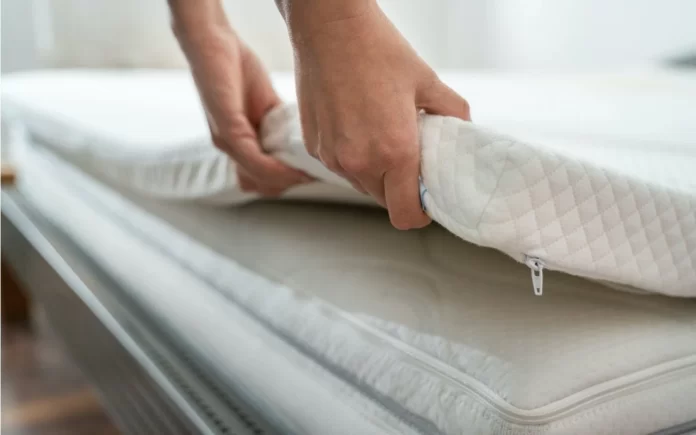Are you struggling to find the best way to store your folding mattress for an extended period? Look no further! This article will provide practical and effective solutions to help you keep your folding mattress in top condition for long-term storage.
Whether you need to store it due to limited space or seasonal use, we’ve got you covered. So, let’s start and discover the most convenient methods to store a long-term folding mattress.
Review contents
Determining the Storage Area
Choosing a suitable storage space
When storing a folding mattress long-term, the first step is to identify a suitable storage area. This space should be well-ventilated, dry, and ideally away from direct sunlight. Selecting a location where the mattress will be protected from moisture, pests, and extreme temperature fluctuations is essential. Consider options such as a basement, attic, or a dedicated storage room.
Preparing the storage area
It’s crucial to prepare the area properly before placing the folding mattress in the storage space. Start by clearing any debris or clutter to create a clean environment. Sweep or vacuum the floor to remove dust and particles that can accumulate over time. If necessary, consider adding a moisture barrier, such as a plastic sheet or a waterproof mat, to protect the mattress from potential moisture seeping from the floor.
Cleaning and Preparing the Folding Mattress
Removing bedding and covers
To ensure the folding mattress is stored in the best possible condition, it’s essential to remove all bedding and covers. Start by stripping off any sheets, blankets, and mattress protectors. If the mattress has a removable cover, take it off and wash it according to the manufacturer’s instructions. Doing so will prevent stains or smells from permeating the mattress during storage.
Vacuuming the mattress
Once the bedding and covers are removed, it’s a good idea to vacuum the folding mattress thoroughly. This will help eliminate any dust, dirt, or debris that may have accumulated on the surface. Use the upholstery attachment on your vacuum cleaner and review the entire mattress, paying attention to crevices and edges. Removing loose particles will minimize the potential for dirt buildup and keep the mattress fresh for future use.
Spot cleaning for stains
If there are any visible stains on the folding mattress, it’s essential to address them before storing them long-term. Start by checking the manufacturer’s guidelines for specific cleaning instructions. If spot cleaning is allowed, use a mild detergent diluted in water and a soft cloth to blot the stained area gently. Take care not to saturate the mattress or rub the stain vigorously, which may lead to further damage. Allow the mattress to dry completely before proceeding to the next step.
Proper Folding Techniques
Consulting the manufacturer’s instructions
Before attempting to fold the mattress, it’s essential to consult the manufacturer’s instructions. Different folding mattresses may have specific guidelines or recommendations that should be followed to ensure longevity and proper storage. These instructions will guide you on the best folding technique, the maximum number of folds allowed, and any additional precautions that should be taken.
Folding the mattress in half
In most cases, folding a folding mattress involves folding it in half lengthwise. Start by finding the center of the mattress and folding one end towards the other until both ends meet. Care to align the edges as evenly as possible to avoid lumps or creases. If the mattress is too long to fold in half, consult the manufacturer’s instructions for alternative folding methods.
Securing the fold with straps or bungee cords
To ensure the fold remains in place during storage, it’s advisable to secure it with straps or bungee cords. These can be wrapped tightly around the mattress to hold the folded position. Alternatively, some folding mattresses come with built-in straps or fasteners that can be utilized for this purpose. Securing the fold will prevent the mattress from unfolding or shifting during transportation and storage.
Protecting the Mattress
Using a mattress storage bag
A mattress storage bag is one of the best ways to protect a folding mattress during long-term storage. These bags shield the mattress from dust, moisture, and pests. When choosing a storage bag, opt for one made of durable, breathable material resistant to tears and mold. Slide the folded mattress into the bag and seal it tightly to provide an extra layer of protection.
Covering with a plastic sheet
In addition to a mattress storage bag, it’s beneficial to cover the folded mattress with a plastic sheet. This will offer an extra barrier against potential moisture or dust. Use a thick, waterproof plastic sheet more significant than the mattress to ensure complete coverage. Wrap the folded mattress tightly with the plastic sheet, ensuring it is sealed securely. This will prevent unwanted elements from entering the storage bag and reaching the mattress.
Avoiding direct contact with the floor
Avoiding direct contact with the floor is essential to protect the folding mattress further during storage. Placing the mattress on a pallet or elevated platform is highly recommended, as it prevents moisture transfer from the ground. This also helps deter pests from accessing the mattress and ensures proper air circulation. Keeping the mattress off the floor minimizes the risk of damage and maintains its quality throughout the storage period.
Choosing the Right Storage Accessories
Using a mattress pad or topper
Consider using a mattress pad or topper before storing the folding mattress for added protection and comfort. These accessories are an additional barrier against dust, moisture, and potential stains. Choose a mattress pad or topper that is breathable, hypoallergenic, and easy to clean. These accessories can also provide cushioning and support, ensuring the folding mattress retains its shape and quality during long-term storage.
Placing moisture absorbers or desiccants
To maintain optimal conditions within the storage area, it’s advisable to place moisture absorbers or desiccants near the folded mattress. These products help absorb excess moisture and prevent mold or mildew growth. To maintain a dry environment, Silica gel packets, charcoal, or commercially available moisture absorbers can be strategically placed in the storage space. Regularly check and replace these products as needed to ensure continued effectiveness.
Avoiding Damage and Pest Infestation
Keeping the mattress away from sharp objects
To prevent damage to the folding mattress, storing it away from sharp objects that could penetrate or tear the material is crucial. Avoid storing the mattress near tools, sharp edges, or any items that could potentially puncture it. By ensuring a safe distance from potential hazards, you’ll minimize the risk of accidental damage and preserve the mattress for future use.
Using mothballs or cedar chips to prevent pests
Pests, such as moths or insects, can cause extensive damage to a folding mattress if left unchecked. Consider using mothballs or cedar chips in the storage area to deter these unwanted visitors. The pungent odor of mothballs is known to repel insects, while cedar chips act as a natural insect deterrent. Place these pest-prevention methods strategically around the folded mattress to create a protective barrier against unwanted pests.
Maintaining Temperature and Humidity Levels
Avoiding extreme temperature fluctuations
Folding mattresses are designed to withstand various temperatures, but significant fluctuations can still impact their quality. When storing a folding mattress, terlong-termngg exposure to extreme temperature changes is crucial. Temperature extremes can cause the mattress material to expand or contract, potentially leading to structural damage. Aim for a storage area that maintains a relatively stable temperature throughout the year.
Monitoring humidity levels
In addition to temperature, monitoring and maintaining suitable humidity levels in the storage area is important. High humidity can promote the growth of mold and mildew, while low humidity can cause the mattress material to dry out and become brittle. By using a hygrometer, you can monitor the humidity levels regularly. Aim for a humidity range of 30% to 50% to ensure the folding mattress remains in optimal condition throughout its storage period.
Periodically Checking and Re-Folding
Checking for any damage or pests
Even with proper storage measures, it’s essential to periodically check on the folded mattress for any signs of damage or pests. Regular inspections allow you to identify issues early on and take appropriate action. Look for signs of mold, mildew, pests, or any structural damage to the mattress. If any concerns are noted, address them promptly to prevent further deterioration.
Re-folding the mattress
During these periodic checks, it is advisable to re-fold the mattress to redistribute pressure points and prevent permanent creasing. Carefully unfold the mattress and refold it using the manufacturer’s recommended method. This helps mitigate the risk of the mattress staying in a single folded position for an extended period, potentially causing uneven wear or damage. By re-folding the mattress, you ensure that the weight and pressure are evenly distributed during storage.
Labeling and Organizing
Labeling the storage space
It’s highly recommended to label the storage space where the folded mattress is kept to make retrieval easier. Using a waterproof marker, clearly label the storage container, bag, or area with the contents. This allows you to locate the folding mattress with ease when you need it in the future. Additionally, you can include the storage date to help track how long the mattress has been stored and anticipate the need for maintenance or replacement.
Organizing the storage area
Maintaining an organized storage area is vital when storing a folding mattress long-term. Keeping the area tidy and well-arranged minimizes the risk of accidentally damaging the mattress when retrieving or moving other items. Consider utilizing shelving, stacking containers, or storage racks to optimize space while ensuring the mattress remains easily accessible. Keep the area free from clutter, and regularly evaluate your storage system to ensure efficiency and safety.
Retrieving and Unfolding the Mattress
Preparing the space for unfolding
When retrieving the folding mattress from storage, preparing the space properly is essential. Clear the area of any obstacles or debris that could interfere with the unfolding process. Ensure there is enough room to extend the mattress without any restrictions fully. By creating a clean and open space, you can ensure a smooth and hassle-free unfolding experience.
I am carefully unfolding the mattress.
To unfold the folding mattress, grip its sides and carefully extend it in a slow and controlled manner. Care to unfold each section evenly to avoid sudden jerks or twists that could potentially damage the mattress. Once fully unfolded, allow the mattress to regain shape and breathe for a few hours before using it. This will ensure maximum comfort and longevity for your folding mattress.
In conclusion, storing a folding mattress long-term requires careful preparation, protection, and maintenance. Following the steps outlined above, you can ensure that your folding mattress remains in excellent condition and is ready for use whenever needed.
From choosing the right storage area to carefully unfolding the mattress after storage, these guidelines will help you keep your folding mattress safe, clean, and comfortable for years.




























